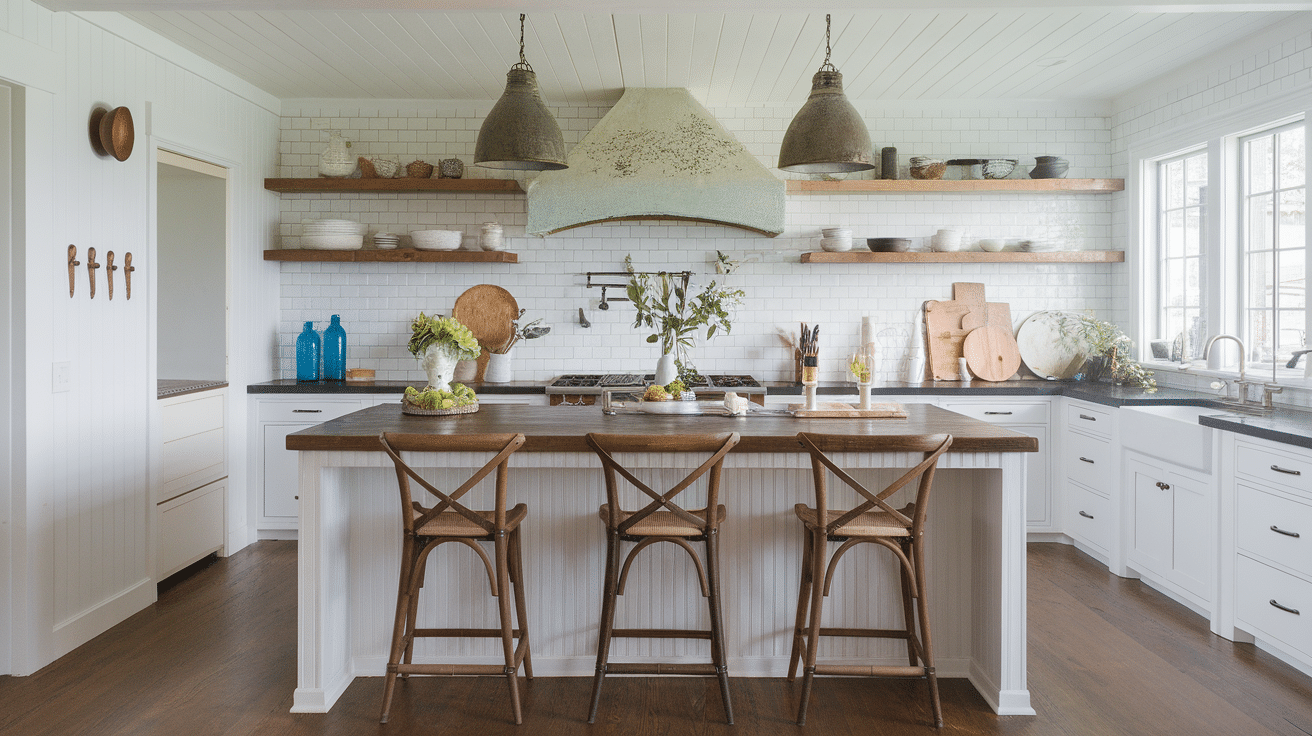Attention DIY enthusiasts! Are you looking to transform your kitchen with a beautiful, functional kitchen island? A beadboard kitchen island adds charm, storage, and extra counter space to any kitchen.
Interest in custom kitchen islands has surged as homeowners seek affordable ways to upgrade their spaces. Beadboard paneling offers that perfect balance of classic style and modern functionality that works in almost any kitchen design.
Desire to create your own beadboard island? You’re in the right place! This project is achievable even for intermediate DIYers, requiring basic woodworking skills and common tools.
Follow our comprehensive guide below to build your own beadboard kitchen island that will become the centerpiece of your kitchen for years to come.
Why You Should Consider a Beadboard Kitchen Island?
A beadboard kitchen island offers both style and function in one simple upgrade. This popular design element can transform your kitchen without breaking the bank.
1. Aesthetic Benefits
- Adds texture and visual interest through distinctive grooves
- Creates timeless, cottage-inspired charm
- Breaks up monotonous kitchen surfaces
- Brings warmth and character to your space
2. Practical Advantages
- Increases counter space for cooking and serving
- Provides valuable additional storage
- Creates a central gathering point
- Serves as a versatile workstation
3. Budget-Friendly Option
- More affordable than custom cabinetry
- Achievable DIY project for beginners
- Customizable to fit your exact space
- Can be completed in a single weekend
With minimal investment, you can create a stunning kitchen focal point that significantly improves both form and function.
Step-by-Step Guide to Building a Beadboard Kitchen Island
Transform your kitchen with this comprehensive guide to creating a beautiful beadboard island.
Tools and Materials You’ll Need
| Item | Purpose/Use |
|---|---|
| Beadboard panels | For the decorative outer layer of the island |
| Plywood or base cabinet units | Forms the structure or core of the island |
| 2x4s or framing lumber | Used to build the base frame |
| Wood glue and construction adhesive | Secures panels and structural elements |
| Screws, nails, and brackets | Fasteners to hold components together |
| Saw, drill, nail gun, measuring tape | Essential tools for cutting and assembly |
| Paint or wood stain | For finishing and protecting the surface |
| Countertop material | The top surface—choose based on style and budget (e.g., butcher block, quartz) |
Pro Tip: Pre-cut beadboard panels and premade base cabinets can save you hours of work and help ensure clean, professional-looking results.
Step 1: Plan Your Island Size and Layout
Before cutting any wood, carefully plan your island’s dimensions based on your kitchen’s available space and your specific needs. Consider traffic flow around the island (minimum 36″ clearance), countertop overhang for seating (10-12″), and how the island will integrate with existing cabinetry.
- Measure your kitchen space
- Decide on storage options and seating
- Sketch your design with all dimensions
Pro Tip: Create a cardboard template of your island’s footprint and place it in your kitchen for a few days to ensure the size and placement work well with your daily routines.
Step 2: Build or Assemble the Base
The foundation of your island determines its structural integrity and functionality. You can either build a custom frame from scratch using 2x4s or repurpose pre-built base cabinets for a simpler approach. Ensure the base is level and securely anchored to prevent wobbling.
- Construct a base frame using 2x4s or use pre-built cabinets
- Add cross supports for stability
- Include mounting points for shelves or drawers
Pro Tip: If using pre-built cabinets, secure them together with clamps and screws through the face frames for a rock-solid foundation.
Step 3: Attach Beadboard Panels
Beadboard panels create the distinctive look that makes your island special. Measure and cut your panels carefully, allowing for trim pieces at corners. Apply construction adhesive to the back of each panel before securing with finish nails for the strongest bond.
- Cut panels to size and attach with adhesive and nails
- Align panels vertically for a classic look
- Use spacers to ensure consistent gaps between panels
Pro Tip: Pre-paint your beadboard panels before installation to ensure complete coverage in the grooves, then touch up after installation.
Step 4: Add Trim and Baseboards
Trim pieces conceal panel edges and create a finished, professional appearance. Crown molding at the top, baseboards at the bottom, and corner molding where panels meet will elevate your island’s aesthetic appeal significantly.
- Cover corners and edges with trim for a polished finish
- Miter corners at 45-degree angles for clean seams
- Caulk all gaps before painting for a seamless look
Pro Tip: When cutting trim, always make your cuts slightly longer than measured and then shave them down for perfect fits – you can always cut more, but you can’t add back what’s been removed.
Step 5: Install Countertop
The countertop is both a functional workspace and visual focal point. Whether you choose butcher block, laminate, or stone, ensure it’s securely attached to the base and properly sealed to protect against moisture and stains.
- Secure your chosen countertop material
- Ensure it overhangs evenly for seating if desired
- Apply appropriate sealer based on material type
Pro Tip: For butcher block countertops, apply mineral oil every few weeks for the first six months to prevent cracking and extend the life of the wood.
Step 6: Paint or Stain the Island
The finish you choose will impact both appearance and durability. Semi-gloss or satin finishes are ideal for kitchen applications as they resist moisture and are easier to clean than flat finishes.
- Use primer first if painting
- Apply multiple thin coats for durability
- Allow proper drying time between coats
Pro Tip: Add furniture feet or decorative toe kicks to give your island a furniture-like appearance that elevates the entire design.
5 Design Tips to Enhance Your Beadboard Island
Turn your functional kitchen island into a stunning focal point with these five designer-approved enhancements.
1. Color Strategy for Visual Impact
- Paint your island in a contrasting color to make it stand out from the perimeter cabinets.
- Consider navy blue, sage green, or charcoal gray against white or neutral surroundings.
- Use semi-gloss or satin finishes for better durability in high-traffic kitchen environments.
2. Lighting That Boosts
- Install pendant lights 30-36 inches above the countertop for both task lighting and visual interest.
- Choose fixture styles that complement your overall kitchen design aesthetic.
- Use dimmable options to create different moods for cooking versus entertaining.
3. Strategic Storage Solutions
- Incorporate open shelving on end caps for cookbooks or decorative items
- Install drawers instead of cabinets for easier access to cooking tools and utensils
- Add specialized storage elements like wine racks, plate dividers, or appliance garages
4. Architectural Details
- Attach decorative brackets or corbels under the countertop overhang for character
- Add furniture-style legs or feet at the corners for a custom, high-end appearance
- Install crown molding along the top edge for a finished, built-in look
5. Functional Additions
- Mount hooks on one end of the island for hanging kitchen towels or oven mitts
- Install a butcher block inset for a dedicated cutting surface within your countertop
- Add an electrical strip beneath the overhang for convenient device charging
Mistakes to Avoid When Building a Beadboard Kitchen Island
Beadboard Not Lining Up Properly:Failure to measure and mark alignment points before installation leads to uneven panels that catch the eye for all the wrong reasons.
Skipping the Primer Before Painting: Applying paint directly to raw beadboard causes excessive absorption and uneven coverage, requiring more coats and resulting in a less durable finish.
Not Leveling the Base Correctly: Building on an uneven foundation causes wobbling, structural instability, and problems with drawers and doors functioning properly.
Using Thin or Low-Quality Panels: Flimsy beadboard panels dent easily and won’t withstand kitchen wear and tear, potentially requiring complete replacement much sooner than quality materials.
Overlooking Electrical or Plumbing Needs: Failing to plan for outlets, sink placement, or appliance connections before building can result in inconvenient workarounds or costly modifications later.
Final Thoughts: Bringing Your Island to Life
Creating a beadboard kitchen island is more than just a home improvement project—it’s an opportunity to craft something uniquely yours. The satisfaction of seeing your custom-built island become the heart of your kitchen is incomparable to purchasing a pre-made option.
Beyond the personal pride, your DIY island typically costs 40-60% less than comparable store-bought alternatives. This cost-effectiveness doesn’t mean sacrificing quality; in fact, your handcrafted island often features superior materials and construction.
We’d love to see how you’ve transformed your kitchen! Consider sharing photos of your finished project to inspire others embarking on their own island adventures.
Remember that each nail, panel, and brushstroke represents your vision—making your kitchen truly one-of-a-kind.














